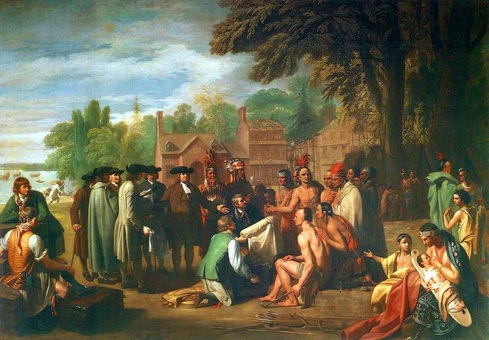Middle Colonies
Reading Material
Middle Colony: New York
The colony that the British named New York was first settled by people from the Netherlands. The Netherlands (often called Holland) is a country in northern Europe. Its people are the Dutch. The Dutch came to the area to set up fur-trading posts. The British, however, wanted this land for themselves so that British settlers in New England could move westward. In 1664, the British captured the colony. England’s king gave the land to his brother, the Duke of York.
New York’s geography made it a good place to settle. New York Harbor was ideal for shipping and trade. The valleys of the Hudson and Mohawk rivers were well suited to farming and trade. Iron, a useful mineral, was found in this region.
Winters in New York were sold, and summers were hot and humid (moist). But there were long growing seasons in the valleys and along the coast. So farming was easier here than in New England.
New York’s economy offered colonists food jobs in many industries. Farmers grew wheat, corn, vegetables, and tobacco. Other colonists became miners, lumbermen, sailors, trappers, and merchants. Some workers were indentured servants or enslaved Africans.
Colonists had little power in New York’s government. Governors appointed by the king were controlled by England. The governor appointed other officials and enforced the laws.
New York’s geography made it a good place to settle. New York Harbor was ideal for shipping and trade. The valleys of the Hudson and Mohawk rivers were well suited to farming and trade. Iron, a useful mineral, was found in this region.
Winters in New York were sold, and summers were hot and humid (moist). But there were long growing seasons in the valleys and along the coast. So farming was easier here than in New England.
New York’s economy offered colonists food jobs in many industries. Farmers grew wheat, corn, vegetables, and tobacco. Other colonists became miners, lumbermen, sailors, trappers, and merchants. Some workers were indentured servants or enslaved Africans.
Colonists had little power in New York’s government. Governors appointed by the king were controlled by England. The governor appointed other officials and enforced the laws.
Middle Colony: Pennsylvania
Quakers were another religious group whose religious beliefs differed from those of other churches. Quakers had no priests or ministers. They would not fight in wars. English Quaker William Penn was jailed several times for his beliefs. He wanted to start a colony where Quakers could live safely. In 1681, England’s King Charles II granted land in North America to Penn. Penn founded Pennsylvania there.
Penn welcomed people from many countries to his colony. They practiced different religions. Penn also treated American Indians with respect. Therefore, they lived in peace with the colonists. Although many colonists opposed slavery, Penn permitted people to bring enslaved Africans to the colony.
Pennsylvania’s geography provided many resources. The Delaware River Valley had rich soil for farming. There were forests for timber. Other raw materials included coal and minerals like iron and copper. Rivers offered easy transportation. Winters were cold and snowy, but the climate did not discourage colonists.
The colony developed a strong economy. There were jobs in many industries. Farmers raised dairy cattle. They also grew wheat and vegetables such as corn. People worked as miners, lumbermen, and merchants. Many Quaker merchants and farmers became rich.
The king approved Penn’s appointment of the colony’s governor. A General Assembly met to pass or reject laws made by the council. All men who owned property could vote for members of the Assembly. In 1696, the colony became more democratic when the elected members of the Assembly gained the power to write laws.
Penn welcomed people from many countries to his colony. They practiced different religions. Penn also treated American Indians with respect. Therefore, they lived in peace with the colonists. Although many colonists opposed slavery, Penn permitted people to bring enslaved Africans to the colony.
Pennsylvania’s geography provided many resources. The Delaware River Valley had rich soil for farming. There were forests for timber. Other raw materials included coal and minerals like iron and copper. Rivers offered easy transportation. Winters were cold and snowy, but the climate did not discourage colonists.
The colony developed a strong economy. There were jobs in many industries. Farmers raised dairy cattle. They also grew wheat and vegetables such as corn. People worked as miners, lumbermen, and merchants. Many Quaker merchants and farmers became rich.
The king approved Penn’s appointment of the colony’s governor. A General Assembly met to pass or reject laws made by the council. All men who owned property could vote for members of the Assembly. In 1696, the colony became more democratic when the elected members of the Assembly gained the power to write laws.
Back: |
Information and Pictures from the Teacher's Curriculum Institute


